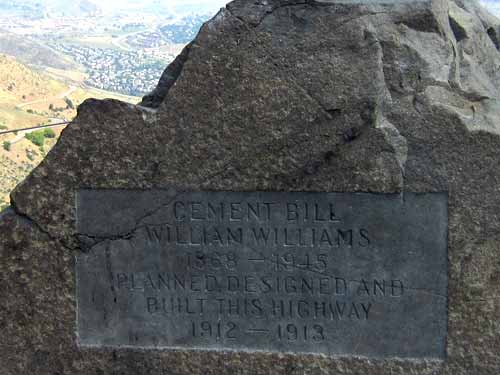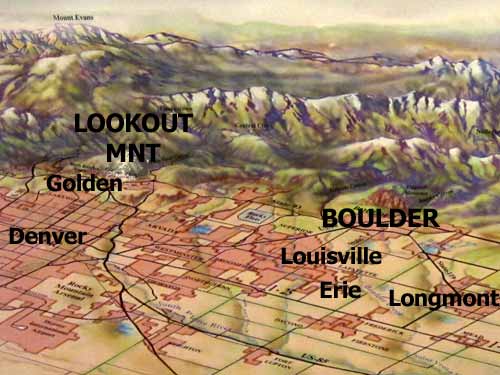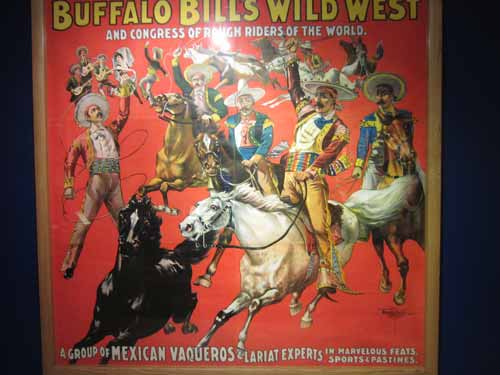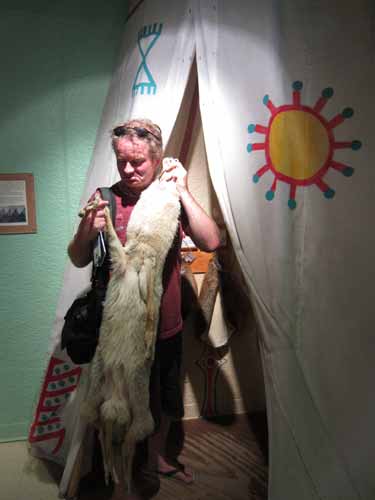
A guy on rollerblade skis makes his way up the very steep road.

Who names their kid William Williams? Poor guy. Love the nickname though!

A hazy view of the Continental Divide


A view of Golden from Lookout Mountain, with the enormous Coors brewery
We spent a lot of time in the museum. It was filled with relics from his life and posters from his shows.
So who was this man? William Frederick Cody was born in 1846 in the Iowa Territory. He moved with his family to a farm in the Kansas Territory when he was 8 years old. Of 7 children, Bill was the only son to live to adulthood.
At age 11, his father died, so Bill began taking on a variety of jobs. He worked on a freight train, running back and forth delivering message between the drivers and the workmen. Next he became an unofficial member of the scouts assigned to guide the army to Utah to put down a Mormon rebellion. This is where he killed his first Indian. At 14, he rode for the Pony Express. He wanted to then enlist as a solder but was refused because of his age. So he began working with a freight caravan which delivered supplies to Fort Laramie. In 1863 he enlisted in the Kansas Cavalry.
The next year, at 18 years of age, he married Louisa Frederici and they had four children. In 1867, he was hired to provide meat for workers on the Kansas Pacific Railroad... 12 bison per day for $500 per month. From 1868 to 1872, he worked as a scout in the US Army.

In 1872, Bill traveled to Chicago to make his stage debut in The Scouts of the Prairie, one of the original Wild West shows. In 1883, he founded his own show... Buffalo Bill's Wild West. They traveled throughout the the States and Europe. Over the years, the show expanded to include other horse-culture groups from around the world. They re-enacted the Pony Express, Indian attacks on wagon trains, and stagecoach robberies.

In 1908, he joined up with Pawnee Bill and Buffalo Bill joined forces and created the "Two Bills" show. Unfortunately, the show was foreclosed on in 1913 when it was playing in Denver, Colorado. At the time of his death in 1917, Bill's great fortune had dwindled to less than $100,000. He died of kidney failure at 71 years of age, surrounded by family and friends at his sister's house in Denver.

Ok, so it was a bit overdone, but it worked.

Bill earned his nickname from his skill as a buffalo (technically either bison or American buffalo) hunter. While working for the railroad, he supposedly killed 4,280 animals in 18 months. Another man, William Comstock, also wanted the nickname, so the two men held a buffalo-shooting match... Cody won with 68 bison to Comstock's 48.
In spite of these numbers, Bill is not considered a part of the destruction of the great herds which happened later, between 1970 and 1883. This was done primarily by hide hunters who received 50 cents to $1.25 per skin. Bill himself spoke out against this practice. By 1888, the herd he owned for his Wild West show was the fourth largest in the country... consisting of only 18 animals.

Bill and Louisa had 4 children, but only two of the girls lived to adulthood, ending the Cody family name for that line.


Bill started riding horses at a very early age and is quoted as saying he felt more at home in the saddle than any other place.

Bill served for four years as an army scout and received the Congressional Medal of Honor in 1872. Years later, one month after his death, the medal was rescinded on account that he had been a civilian when he received it. But 72 years after that, they changed their mind again and reinstated it, concluding that even though he wasn't an enlisted soldier, he had still performed with the necessary bravery worthy of keeping it.

Be careful where you rest your arm... those teeth look sharp!
THE SHOW:

Bill was a strong advocate of equal rights, both for women and Native Americans. In the years before the Civil War, Kansas was high with emotion on both sides of the slavery question. In 1854, Bill's father, Issac, spoke at a public meeting against allowing slavery in Kansas. Before he could finish, a pro-slavery member of the crowd stabbed him twice. He recovered but he and his family were threatened and harassed several times. Three years later, Isace fell ill and, still in a weakened condition from the knife wound, died. This early influence from his father gave Bill his sense of justice and equality.

Many of these images were foreign to folks back on the East coast.



The shows went to Europe several times in the 1880's. Special performances were given for Queen Victoria of England and other European royalty.

A desert Bedouin and a Moorish horseman

Mexican vaqueros

A silver dollar shot through by Bill

Bill met James "Wild Bill" Hickok when he was only 11 years old and working on a wagon train. Hickok was 21 years old and defended him once from a bullying wagon driver. They were friends ever since. In 1873, Hickok left law enforcement to join Cody's show. He left six months later (due to drinking heavily and getting into fights with everyone) and was shot couple years after that in Deadwood.

After the loss of the show, assets had to be sold. Included was Bill's favorite horse, Isham. They had been together since 1888. On the day of the auction, the horse was purchased for $150 by one of Bill's friends and returned to him as a gift.
THE INDIANS:

"Custer's Last Fight" painted in 1884 by Cassidy Adams was reproduced on thousands of posters and distributed by Anheuser Busch to taverns throughout the country.

Captions beneath the painting label these characters as "General Custer" and "Half Breed."
"Nobody knew who killed Custer; everybody fired at him. Custer was a brave warrior but made a mistake. The Indians honored him and did not scalp him. I fought for my people. My people said I was right. I will answer to my people. I will answer for the dead of my people. Let the palefaces do the same on their side." - Sitting Bull

Scalping is the act of removing a portion of the scalp either from a dead or still living person. The initial purpose was to provide a battle trophy. Although it is often associated with the warfare of the Wild West, it actually has been a world practice since the dawn of time.

A re-enactment from the show. Buffalo Bill became friends with George Custer while working for the army. Custer's death came as a personal blow. Bill partook in other battles and took what became known as "the first scalp for Custer" as a revenge for his friend.
So how does it go from that...

... to this?
Apparently it was a question of forgiveness on both sides. Even as a frontier scout, Bill respected Native Americans and supported their rights and way of life. He called them "the former foe, present friend, the American", and once said, "Every Indian outbreak that I have ever known has resulted from broken promises and broken treaties by the government."
Buffalo Bill's Wild West operated from 1883 to 1913, during which over 500 Native Americans performed with the show. Mostly they were Lakota, but there were also Pawnee and Arapaho. The show gave them the opportunity to leave the reservations, continue a life they had known, and help them preserve their culture by sharing it with the world.
While the Indians were often depicted attacking wagon trains only to be driven off by cowboys and soldiers, Bill also had the wives and children of his Indian performers set up camp as part of the show. This gave his audience the opportunity to see the human side of these people; that they had families like any other but were just part of a different culture.

Iron Tail (picture with Buffalo Bill) joined the show in the 1890's and was always happy to pose for photos.

Sitting Bull (1831-90) was a leader of the Hunkapapa Lakota (members of the Sioux nation). He gained notoriety when he, along with Chief Crazy Horse, fought against George Custer in the Battle of Little Big Horn in 1876. After his eventual surrender in 1881, Sitting Bull still hoped to preserve the Sioux way of life. In 1885, Bill hired Sitting Bull as an attraction for the show, to try to share the Native American culture. Unfortunately audiences greeted him with boos and jeers for his role in the Custer conflict. Sitting Bull left after only several months, but Bill gave him the pony he had ridden in the show as wall as a large white western hat, both of which Sitting Bull seemed to cherish until he died.

Short Bull of the Lakota

The tipi was filled with all sorts of animal pelts, such as this coyote.
THE COWBOYS:

I like how they are all soooo darn cool that they can't even look at the camera.


Now the fun part of the museum... dress like a cowboy!

Some of the things you could try on

Roping the steer
THE FAME:

Now this could be interesting!

Prairie Ranch Flavor, no less... whatever that is!

In 1876, Bill's only son died of scarlet fever at the age of 7. Six year later, Bill met Johnny Barker, who would have been the same age as Bill's real son. While never formally adopted, he was known as Bill's foster son. He founded the museum a few years after Bill died in 1917. It eventually went to the city of Denver in 1957.
We then headed outside to the actual grave.

The town of Cody (which Bill had founded in Wyoming) fought hard to have him buried there. In 1948, a reward was even offered for the "return" of the body. So a guard was placed by the grave until a deeper shaft could be blasted into the rock. When his wife, Louisa finally passed away and was buried with him, several feet of cement was poured over the whole thing, ending the discussion once and for all.


Bill was the highest level one could acheive, a 32 degree mason.

